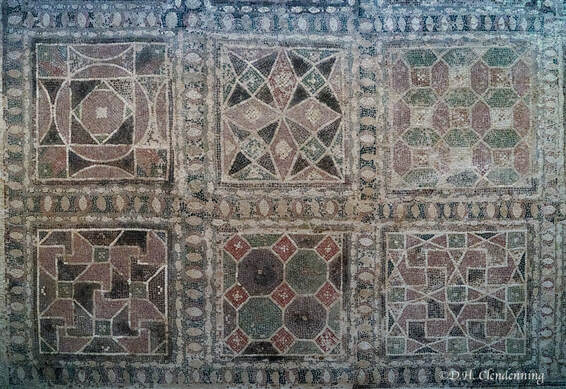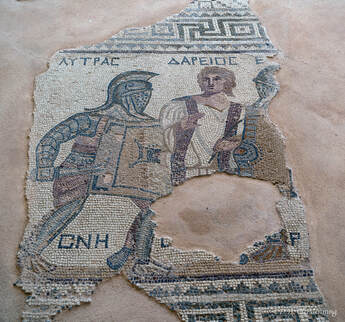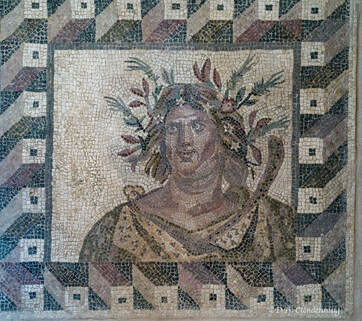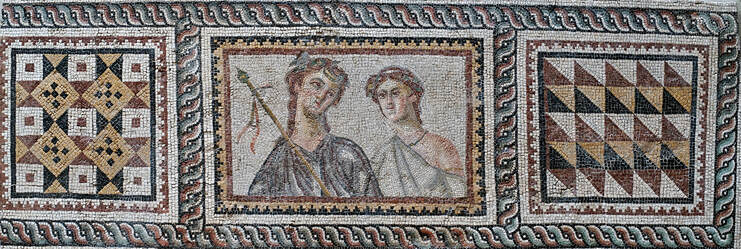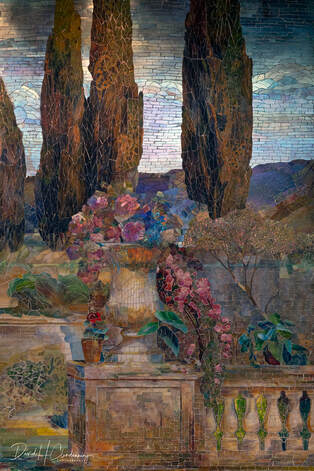Mosaics
Greek Floor Mosaics
In this mosaic floor, the compositions are placed in a grid of squares. This greek and roman technique of structuring a composition would be adopted and adapted by Islamic craftsmen.
Roman Art - Mosaics
 Title: Roman Floor Border Mosaic.
Order No.: A1-1744.
Location: Daphne area, Antioch (Worcester Museum, MA).
Title: Roman Floor Border Mosaic.
Order No.: A1-1744.
Location: Daphne area, Antioch (Worcester Museum, MA).
House of the Vine Scroll - Mosaic border fragment - Material stone cubes (limestone & marble) embedded in line mortar
The border is filled with a vine scroll inhabited by birds and animals, as well as a twisting ribbon of grey, pink, and yellow cubes of stone (tesserae) against a black background. Mosaicists skillfully created the illusion of a three-dimensional ribbon which echoes the curves of the scrolling vine.
Two brilliantly coloured peacocks face a basket full of grapes. As these are the only peacocks around the entire border, the artist intended to highlight their importance. Like the basket of grapes, the peacocks could simply refer to the abundance and beauty of the natural world, but they were also symbolic for the ancients. In the Roman world peacocks were linked with immortality and eternal life, perhaps because they shed their tail feathers in winter and renewed them in the spring. Symmetrically paired peacocks and inhabited vines were adapted by the early Christians for use in their churches and tombs.
Floor mosaics are often found in grand rooms that served as reception and banqueting halls. Mosaic floors were inspired by textile designs. Floral and geometric "carpet" mosaics became very popular in the late Roman and early Byzantine periods. The composition of an elaborate border surrounding a simple repeating pattern, such as scattered roses, was flexible and could be applied to rooms of all shapes and sizes.
Two brilliantly coloured peacocks face a basket full of grapes. As these are the only peacocks around the entire border, the artist intended to highlight their importance. Like the basket of grapes, the peacocks could simply refer to the abundance and beauty of the natural world, but they were also symbolic for the ancients. In the Roman world peacocks were linked with immortality and eternal life, perhaps because they shed their tail feathers in winter and renewed them in the spring. Symmetrically paired peacocks and inhabited vines were adapted by the early Christians for use in their churches and tombs.
Floor mosaics are often found in grand rooms that served as reception and banqueting halls. Mosaic floors were inspired by textile designs. Floral and geometric "carpet" mosaics became very popular in the late Roman and early Byzantine periods. The composition of an elaborate border surrounding a simple repeating pattern, such as scattered roses, was flexible and could be applied to rooms of all shapes and sizes.
Modern Day Mosaics
|
A Small Section of the Dream Garden mosaic
Tiffany's work in mosaic, inspired by Byzantine examples, dates to the 1880s, when he began experimenting with iridescent glass and transparent tesserae backed with metal leaf. Mosaic decoration graded countless interiors by him, from churches to department stores. - The Met, N.Y.C. |
